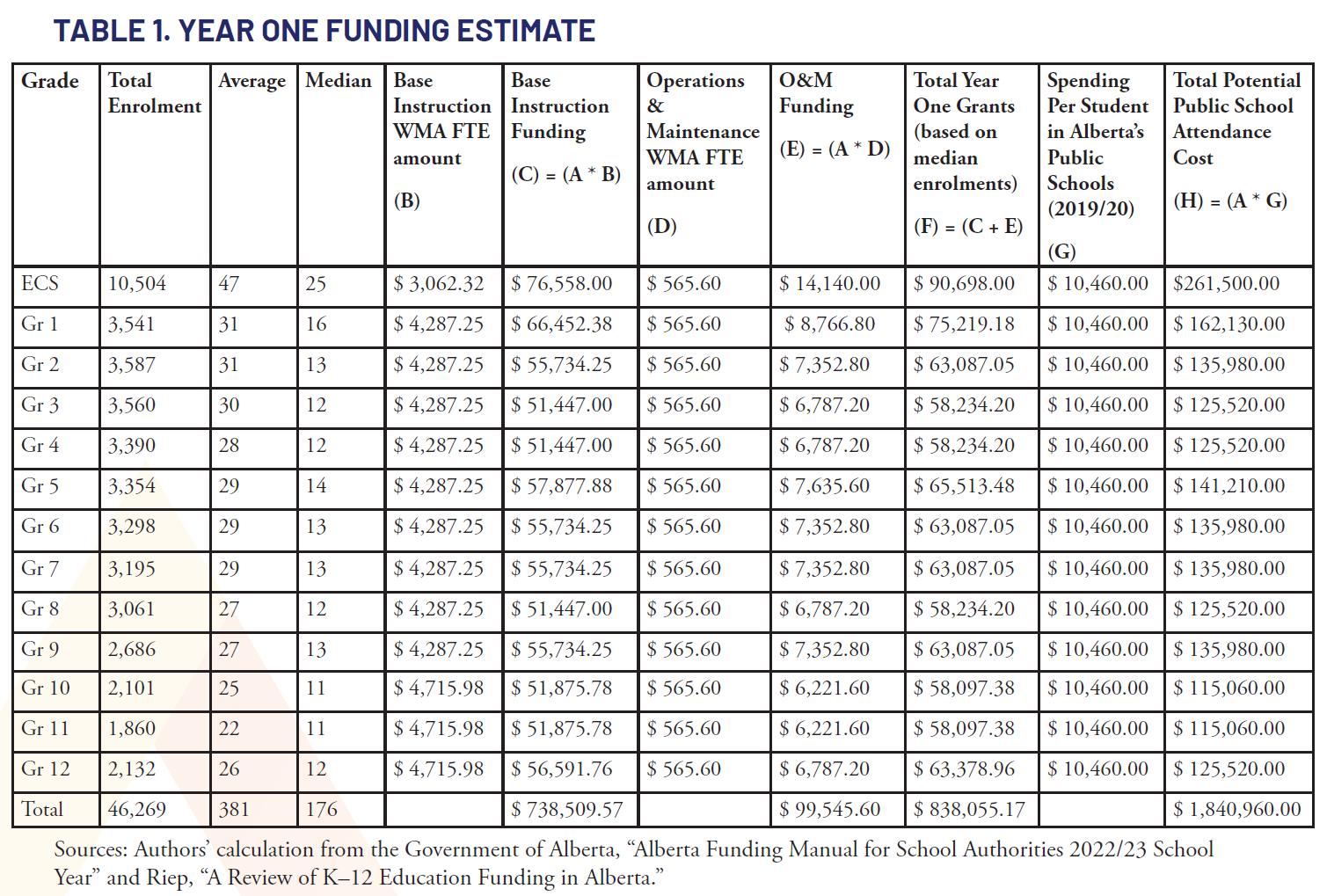Table of Contents
Table of Contents
Issue
Alberta has a diverse taxpayer-funded education system offering a plurality of schooling options to families. These publicly funded options include partial funding for certain independent schools (known formally as accredited funded private schools). 1 1 Government of Alberta, “Private Schools,” https://www.alberta.ca/private-schools.aspx. Section 8 of the Private Schools Regulation makes a distinction between private school operators and the schools themselves. In 2022, existing operators that started additional schools became eligible for first-year funding. However, new operators starting their first accredited, funded school remain ineligible for funding during their first year. 2 2 Private Schools Regulation, Alta Reg 127/2022, https://open.alberta.ca/publications/2022_127. This gap contributes to a higher risk of operational failure for new operators and imposes an inequitable cost on families attending those new schools. Further, this funding obstacle undermines full educational pluralism by inhibiting the creation of schools by new operators who are being innovative and responding to the changing needs of Albertan students.
Recommendation
While the Minister has the authority to exempt this limit on eligibility, Section 8 of the Private Schools Regulation should be amended to provide funding for new operators that start new schools, beginning in year one. Building on the change made in 2022, this permanent change to the regulations would provide funding certainty for families and new operators during their first year.
One possible rationale for withholding funding is that new operators should have to demonstrate their ability to successfully operate a school that is fully compliant with the regulations. However, failure to provide adequate funding at start-up may actually undermine that goal and contribute to an increased likelihood of operational failure. Further, our estimates show that families stand to benefit from significant cost relief in the first year if this change is made. While this change would represent a new cost for the Ministry, the government stands to benefit from net savings in the long-term as funded independent schools generally receive 70 percent of funding compared to their public counterparts.
Background
Grants to Eligible Accredited (Funded) Independent Schools
Accredited funded schools are eligible for five broad types of grants including: (1) Base Instruction Grants, (2) Program Supports and Services Grants, (3) School-Based Grants, (4) Community-Based Grants, and (5) Authority-Based Grants. The Base Instruction Grants form the bulk of the amount that eligible independent schools receive, with the total amount calculated based on the Weighted Moving Average (WMA) enrolment of Full Time Equivalent (FTE) students. From the 2020/21 school year, Alberta transitioned from using the annual student count as the basis for its grants to the WMA approach. The WMA approach does not allocate funding on a per-school or per-student basis. Instead, the approach allocates funding for the school authority using the weighted average of three years of enrolment data. From years one to three, the WMA approach does not impact new independent schools (either new schools by existing operators or new operators who receive a waiver). These schools receive funding for their actual enrolment because they do not have previous enrolment data.
3
3
Government of Alberta, “Funding Manual for School Authorities 2022/23 School Year,” August 2022, 126, https://open.alberta.ca/dataset/8f3b4972-4c47-4009-a090-5b470e68d633/resource/e7865589-6774-4ba8-89b5-a61ca2f36843/download/edc-funding-manual-2022-2023-school-year.pdf.
Policy Details
Assumptions for Cost Estimate
Estimating the cost of this policy change is complex as enrolment numbers for independent schools vary widely. This estimate employs a few simplifying assumptions to determine the potential cost relief for new schools and for the government if schools are funded during the first year of operation:
- Funding is based on 100 percent of the enrolment count for the first year of operation.
- The estimates do not include the Base Instruction Funding for Designated Special Education Private Schools (DSEPS) (i.e., funding for students with mild, moderate, or severe disabilities)
- All grade 12 students are considered to be in their third year of high school as the base instruction amount decreases after the third year of high school.
- Our estimates are based on the median (not average) enrolment in Early Childhood Services (ECS), and grades 1 to 12 for each grade across Alberta’s independent schools in 2021/22. Given the range, using the average enrolment numbers would have skewed the calculation upwards.
Table 1 shows the total, average, and median enrolment across Alberta’s independent schools by grade in the 2021/22 school year. The Base Instruction Grant and the Operations and Maintenance Grant are the only grants included because they are the primary, general grants that are tied to enrolment. The other grants are more specific to factors such as program offerings (e.g., English as a second language grants) or are community-based. A newly operating independent school with the median enrolment at each grade (a total of 176 students) would be eligible to receive $838,055 in total funding during its first year. Without the recommended regulation change, parents would bear these costs in year one.
A study by the Public School Boards’ Association of Alberta estimated that in 2019/20, per-student funding for Alberta’s public-school divisions ranged from $9,319 to $30,522. The average per-student funding for public schools across the province was $10,460. 4 4 C. Riep, “A Review of K–12 Education Funding in Alberta,” Public School Boards’ Association of Alberta, May 2021, https://public-schools.ab.ca/wp-content/uploads/2021/06/A-Review-of-K-12-Education-Funding-in-Alberta.pdf. Using these numbers, if the median number of students within each grade (a total of 176 students) who attended a new independent school were to attend a public school instead, the cost to the Treasury could amount to $1.84 million. Previous studies have shown that funding independent schools results in overall savings for taxpayers. 5 5 D. Hunt, A. Momoh, and D. Van Pelt, “Funding All Students: A Comparative Economic Analysis of the Fiscal Cost to Support Students in Ontario Independent Schools,” Cardus, 2021, https://www.cardus.ca/research/education/reports/the-cost-to-fund-students-in-ontario-independent-schools/ . While changing the regulations as recommended may be a new cost for the government, the long-term net effect of the change would actually represent a cost saving for the government overall, while providing significant support to families and new independent-school operators.

